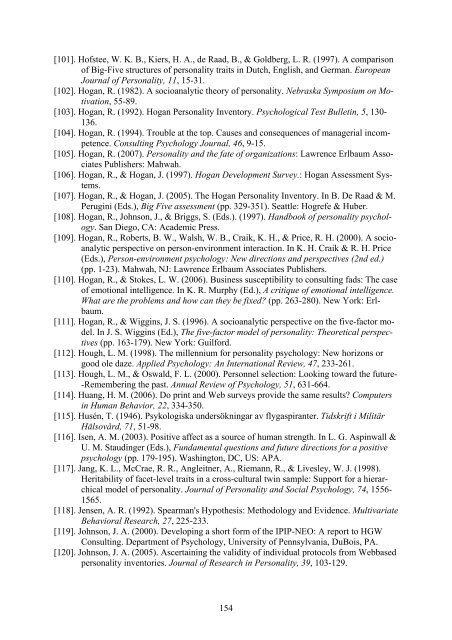Bortom_Big_Five_28_nov_noc _pm_metod.pdf - Från One.com
Bortom_Big_Five_28_nov_noc _pm_metod.pdf - Från One.com
Bortom_Big_Five_28_nov_noc _pm_metod.pdf - Från One.com
Create successful ePaper yourself
Turn your PDF publications into a flip-book with our unique Google optimized e-Paper software.
[101]. Hofstee, W. K. B., Kiers, H. A., de Raad, B., & Goldberg, L. R. (1997). A <strong>com</strong>parison<br />
of <strong>Big</strong>-<strong>Five</strong> structures of personality traits in Dutch, English, and German. European<br />
Journal of Personality, 11, 15-31.<br />
[102]. Hogan, R. (1982). A socioanalytic theory of personality. Nebraska Symposium on Motivation,<br />
55-89.<br />
[103]. Hogan, R. (1992). Hogan Personality Inventory. Psychological Test Bulletin, 5, 130-<br />
136.<br />
[104]. Hogan, R. (1994). Trouble at the top. Causes and consequences of managerial in<strong>com</strong>petence.<br />
Consulting Psychology Journal, 46, 9-15.<br />
[105]. Hogan, R. (2007). Personality and the fate of organizations: Lawrence Erlbaum Associates<br />
Publishers: Mahwah.<br />
[106]. Hogan, R., & Hogan, J. (1997). Hogan Develo<strong>pm</strong>ent Survey.: Hogan Assessment Systems.<br />
[107]. Hogan, R., & Hogan, J. (2005). The Hogan Personality Inventory. In B. De Raad & M.<br />
Perugini (Eds.), <strong>Big</strong> <strong>Five</strong> assessment (pp. 329-351). Seattle: Hogrefe & Huber.<br />
[108]. Hogan, R., Johnson, J., & Briggs, S. (Eds.). (1997). Handbook of personality psychology.<br />
San Diego, CA: Academic Press.<br />
[109]. Hogan, R., Roberts, B. W., Walsh, W. B., Craik, K. H., & Price, R. H. (2000). A socioanalytic<br />
perspective on person-environment interaction. In K. H. Craik & R. H. Price<br />
(Eds.), Person-environment psychology: New directions and perspectives (2nd ed.)<br />
(pp. 1-23). Mahwah, NJ: Lawrence Erlbaum Associates Publishers.<br />
[110]. Hogan, R., & Stokes, L. W. (2006). Business susceptibility to consulting fads: The case<br />
of emotional intelligence. In K. R. Murphy (Ed.), A critique of emotional intelligence.<br />
What are the problems and how can they be fixed? (pp. 263-<strong>28</strong>0). New York: Erlbaum.<br />
[111]. Hogan, R., & Wiggins, J. S. (1996). A socioanalytic perspective on the five-factor model.<br />
In J. S. Wiggins (Ed.), The five-factor model of personality: Theoretical perspectives<br />
(pp. 163-179). New York: Guilford.<br />
[112]. Hough, L. M. (1998). The millennium for personality psychology: New horizons or<br />
good ole daze. Applied Psychology: An International Review, 47, 233-261.<br />
[113]. Hough, L. M., & Oswald, F. L. (2000). Personnel selection: Looking toward the future-<br />
-Remembering the past. Annual Review of Psychology, 51, 631-664.<br />
[114]. Huang, H. M. (2006). Do print and Web surveys provide the same results? Computers<br />
in Human Behavior, 22, 334-350.<br />
[115]. Husén, T. (1946). Psykologiska undersökningar av flygaspiranter. Tidskrift i Militär<br />
Hälsovård, 71, 51-98.<br />
[116]. Isen, A. M. (2003). Positive affect as a source of human strength. In L. G. Aspinwall &<br />
U. M. Staudinger (Eds.), Fundamental questions and future directions for a positive<br />
psychology (pp. 179-195). Washington, DC, US: APA.<br />
[117]. Jang, K. L., McCrae, R. R., Angleitner, A., Riemann, R., & Livesley, W. J. (1998).<br />
Heritability of facet-level traits in a cross-cultural twin sample: Support for a hierarchical<br />
model of personality. Journal of Personality and Social Psychology, 74, 1556-<br />
1565.<br />
[118]. Jensen, A. R. (1992). Spearman's Hypothesis: Methodology and Evidence. Multivariate<br />
Behavioral Research, 27, 225-233.<br />
[119]. Johnson, J. A. (2000). Developing a short form of the IPIP-NEO: A report to HGW<br />
Consulting. Department of Psychology, University of Pennsylvania, DuBois, PA.<br />
[120]. Johnson, J. A. (2005). Ascertaining the validity of individual protocols from Webbased<br />
personality inventories. Journal of Research in Personality, 39, 103-129.<br />
154















